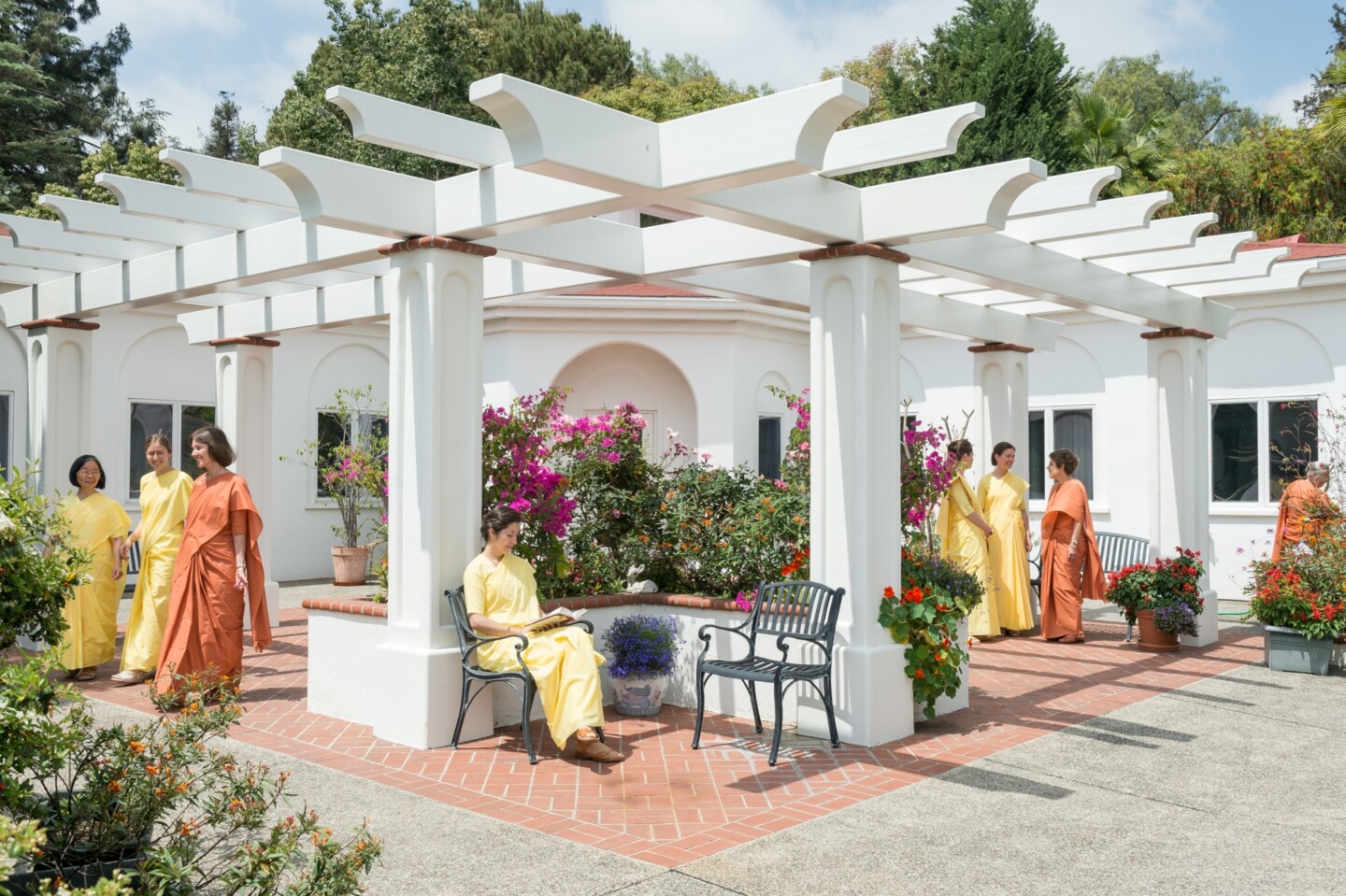Introduction
“The way of complete renunciation is embraced joyously by those who want to see God, and naught else but God. He reveals Himself to those who live by the renunciant’s creed: ‘God is my life. God is my love. God is the temple that calls my heart to unceasing worship. God is my Goal. No duty can be performed without the power borrowed from God, so my highest duty is to find Him.’”
Paramahansa Yogananda
“A Joy That Increases With the Years” | Give Me Thy Heart: The Life of SRF Nuns in Yogananda’s Ashrams
“Finding Joy in Seeking God Together” | Give Me Thy Heart: The Life of SRF Monks in Yogananda’s Ashrams
At the heart of Self-Realization Fellowship is a dedicated monastic order founded by Paramahansa Yogananda.
Self-Realization Fellowship monks and nuns serve the society’s worldwide spiritual and humanitarian work in many capacities — from publishing the writings and recordings of Paramahansaji and his direct disciples, providing spiritual counsel, and conducting temple services, retreats, and lecture tours, to maintaining the buildings, meditation gardens, and ashrams; overseeing the distribution of the SRF Lessons and books; and fulfilling many administrative, office, and other duties required for carrying on the work of an international religious organization.
However, the principal calling of every Self-Realization Fellowship monk and nun is to grow daily in pure love and longing for God — surrendering all lesser desires of the ego so that God becomes the all-consuming Reality of his or her existence, every moment, every day, until final liberation in Spirit is achieved.

A Centuries-old Tradition
Throughout all ages, the most profound impulse of the human spirit has been the longing for perfect love, understanding, joy, completeness — for Truth itself. In all the great religions of the world, there have been those who have chosen to forgo family life and worldly responsibilities in order to give themselves singleheartedly to that divine quest.
Following this centuries-old tradition, Self-Realization Fellowship monks and nuns embrace a fourfold vow of renunciation: simplicity, celibacy, obedience, and loyalty. In the religious orders of both East and West, such vows are the very foundation of the monastic life.
India’s Ancient Swami Order
Paramahansa Yogananda and his guru, Swami Sri Yukteswar, are a part of the ancient monastic Swami Order of India, reordered in its present form centuries ago by Adi Shankaracharya and continuing to the present through an unbroken line of venerable teachers. All monks of the Swami Order trace their spiritual lineage to the first Shankaracharya. They take vows of poverty (nonattachment to possessions), chastity, and obedience to the head or spiritual authority. In many ways the Catholic Christian monastic orders resemble the more ancient Order of Swamis. There are 10 subdivisions of the Swami Order, including the Giri (“mountain”) branch to which Swami Sri Yukteswar and Paramahansa Yogananda belong.
Self-Realization Fellowship monks and nuns who take their final renunciant vows are members of the Swami Order.
Paramahansa Yogananda established the first SRF monastic community in the early 1930s with the arrival of Sri Daya Mata (1914–2010) and other dedicated disciples who wished to renounce worldly life and give their lives completely to God. After Paramahansaji’s passing in 1952, the SRF monastic communities continued to grow under the leadership of the disciples who succeeded him as president and spiritual head of his society (including Yogoda Satsanga Society of India, the name by which Paramahansa Yogananda’s work is known in India).
Sri Daya Mata played a key role during her long tenure, taking a very active interest in developing the renunciant training program and SRF/YSS ashram facilities in the USA, Europe, and India. She was assisted in these efforts for many decades by Sri Mrinalini Mata (1931–2017), who served as vice president of SRF/YSS and succeeded Sri Daya Mata as president in 2011. In 2017 Brother Chidananda was named president and assumed the responsibility of guiding the monastic communities of SRF/YSS. These communities continue to thrive today, filled with hundreds of monks and nuns who have felt called to devote their lives to seeking God and serving humanity.
Daily Life in the Ashram
Daily Life in the Ashram
As a monk, my life has been offered in unreserved service to God and to the spiritual awakening of hearts with His message....The organizational work that God and my Guru and Paramgurus have started through me is carried on by those who have dedicated their lives to the highest objectives of renunciation and love for God.
Paramahansa Yogananda
Diverse Backgrounds United
In keeping with the two great commandments given by Christ, the monastic ideal is to love God with all one’s heart; and to love one’s “neighbor,” not only in abstract theory but in all the interactions of daily life — seeing in each person the image of God, and feeling for each one’s needs as we would for our own. “Once we were strangers,” said Paramahansaji, “but when we love God we become brothers and sisters.”
SRF monks and nuns come from a wide spectrum of backgrounds — men and women of diverse races, cultures, religious upbringings, educational development, and career experience. But what all monastics have in common is an ardent desire to live for God alone.
Through self-discipline, introspection, devoted meditation and a total giving of one’s self in loving service, the monastic seeks to experience the deeper joys of the soul and the supreme love that only God can give.
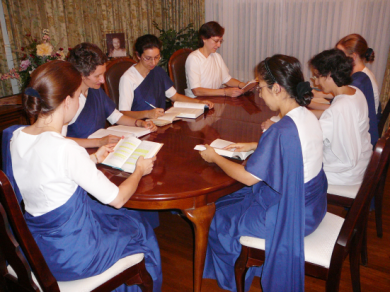
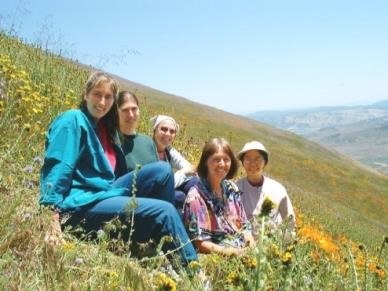
Living in the ashram has given me the freedom to live my dream — making God the polestar of my life, and dedicating myself entirely to seeking and serving God and Guruji is the most fulfilling life I could have ever imagined.
Nun in ashram for 14 years
Daily Life in the Ashram
The renunciant’s daily schedule may vary depending on the particular ashram center and area of work to which he is assigned, but it always includes the basic elements Paramahansaji stressed for a balanced spiritual life: meditation and prayer, service, spiritual study and introspection, exercise and recreation, and time for solitude and silence.
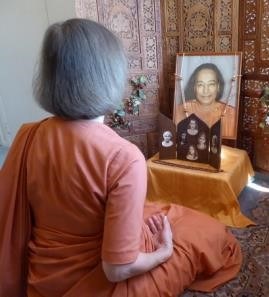
Serving SRF’s Worldwide Mission
SRF monks and nuns serve the society’s worldwide spiritual and humanitarian work in many capacities:
Publishing (in all media) the writings and recordings of Paramahansaji and his direct disciples
Providing spiritual counsel
Conducting temple services, retreats, and lecture tours
Managing the administration of more than 600 centers and groups worldwide
Maintaining SRF buildings, meditation gardens, and ashrams
Overseeing the distribution of the SRF Lessons, books, ebooks, and recordings
Performing the many administrative, office, and other functions required for carrying on the work of an international religious organization
While modern methods are used in these diverse activities, the guiding principle is always to preserve the purity and spirit of the special dispensation that Paramahansa Yogananda was ordained to bring to the world by the SRF line of Gurus. The supreme calling of every Self-Realization Fellowship monk and nun is to grow daily in attunement with God, which makes it possible to serve with understanding and compassion toward all.
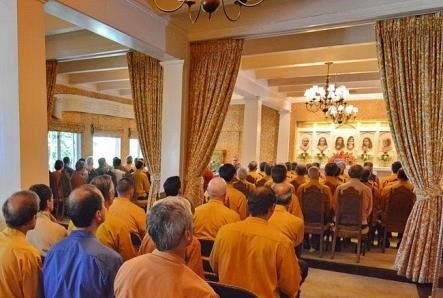
More and more I realize what a blessing it is to live, serve, and to be free to seek God in my Guru’s ashrams, surrounded by such sincere and dedicated souls.
Monk in ashram for 7 years
The Four Stages of Monastic Life
“Here I lay at Thy feet
My life, my limbs, my thoughts and speech.
For they are Thine; for they are Thine.”
— Paramahansa Yogananda
There are four stages of monastic life in the ashrams of Self-Realization Fellowship, representing a gradual deepening of one’s commitment to the renunciant life and the monastic vows. These stages are not of any fixed length. Rather the spiritual growth of each monk or nun, and the readiness of that renunciant to dedicate himself or herself more fully to this life, are always considered on an individual basis.
Postulancy
The first stage, or postulancy, usually lasts for two years. Postulants follow a monastic routine that includes group and individual meditation, spiritual study and instruction, and service in whatever areas are assigned to them. The postulant program is designed to give the renunciant a fuller understanding of the monastic ideals and way of life. Its emphasis is on helping the postulant to develop the attitudes and habits that will assist that renunciant in deepening his or her spiritual life and attunement with God and the Guru. This first stage of monastic life helps the renunciant to gauge the depth of his or her desire to embrace the path of renunciation, and at the same time allows those responsible for the renunciant’s spiritual welfare to guide him or her to an ever deepening understanding of the monastic life.
The Novitiate
At the end of the postulant stage, if both the postulant and counselors remain convinced that he or she is well-suited to ashram life, the postulant will be invited to take the Novitiate Vow. With this vow, renunciants pledge in a more formal way to live by the fourfold monastic vow. During the novitiate period, the novice is expected to demonstrate a growing understanding of monastic discipleship by his or her application of the principles learned at the postulant stage.
Brahmacharya
If after several years the novice has demonstrated an increasing desire and ability to dedicate his or her life wholly to seeking and serving God as an SRF monastic, he or she is invited to take the vow of brahmacharya. (Brahmacharya is a Sanskrit word referring to the discipline and self‑control of one’s thoughts and actions for the purpose of achieving union of the self with Spirit.) This vow signifies the disciple’s deepening intention to remain a monastic in the ashrams of Self-Realization Fellowship, living by the vows of simplicity, celibacy, obedience, and loyalty to the end of life.
After taking this vow, a monk is referred to as a brahmachari and a nun as a brahmacharini. Use of the family name is dropped and within the ashram the monastic is addressed by title and first name — for example, “Brahmachari John” or “Brahmacharini Mary.” A brahmachari or brahmacharini understands that he or she may be asked to assume greater responsibility in the ashram — perhaps training as a temple service leader, taking on special assignments, or serving in other capacities as directed by those responsible for guiding the monastic spiritually.
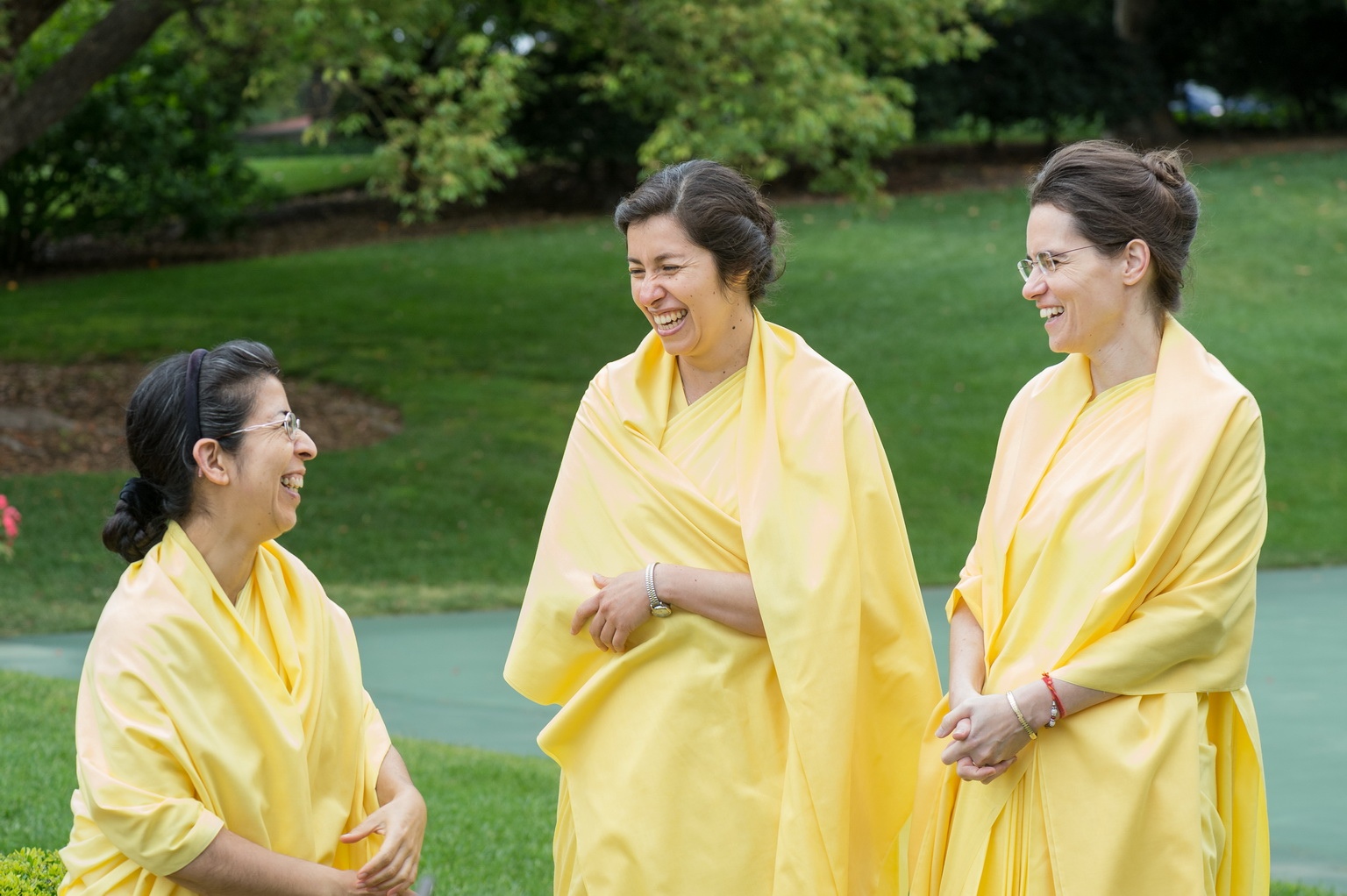
Sannyas
The final vow of sannyas represents the renunciant’s total, lifetime commitment to God, Guru, the Paramgurus, and Self‑Realization Fellowship; and to the SRF monastic vows and ideals, which he or she pledges to observe faithfully as a monk or nun of Self‑Realization Fellowship. It signifies the monastic’s inner determination of soul to set aside all lesser desires in order to live for God alone, and with unconditional dedication and loyalty to serve Him through the path of Self‑Realization Fellowship. The sannyas vow is taken only after many years of living the monastic life, and after the brahmacharis or brahmacharinis have proved to themselves and their superiors that they are ready to make this final commitment. The vow corresponds to that taken by members of the ancient Swami Order in India. When the monk or nun becomes a sannyasi or sannyasini, he or she is given a monastic name of Sanskrit origin, signifying a particular spiritual ideal or quality to exemplify or attain. Monks who have taken this vow are addressed as “Brother” (or, in India, “Swami”). Nuns are addressed as “Sister” (or in India, “Mai”).
With the complete dedication of one’s life and being to the Divine, the sannyasi strives ever more diligently for perfection of character, of service, and, above all, of love for God. He or she assumes a sacred responsibility to exemplify the high ideals of Paramahansa Yogananda’s teachings and society; and, through that example, to inspire and encourage others in their divine quest.
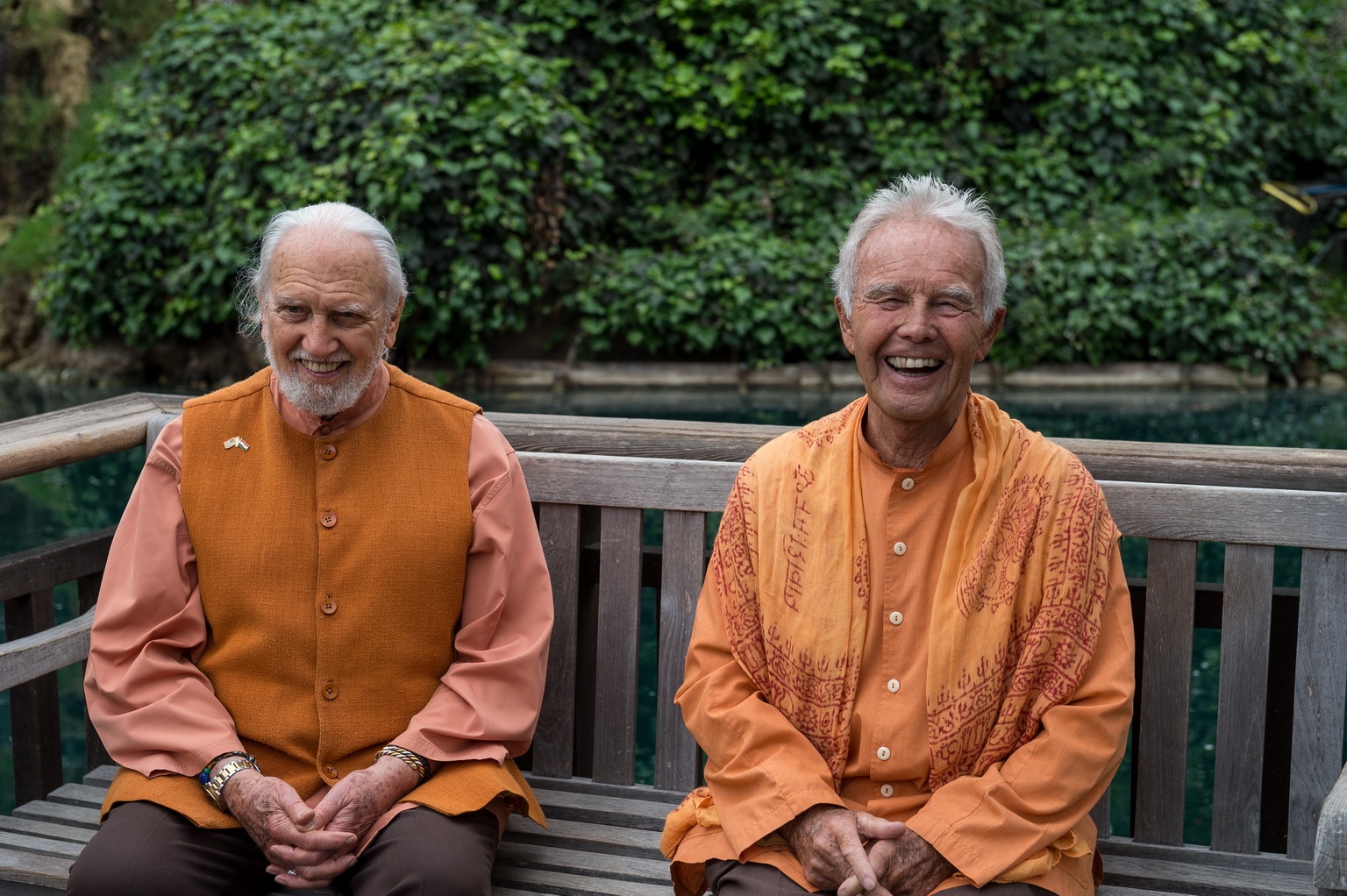
Have You Heard the Divine Call?
The Monastic Vocation
Absorb thy mind in Me; become My devotee; resign all things to Me; bow down to Me. Thou art dear to Me, so in truth do I promise thee: Thou shalt attain Me! Forsaking all other dharmas (duties), remember Me alone!
The Bhagavad Gita
Does your heart feel drawn to a life devoted wholly to God and Guru, and to serving Their divine mission?
Have you yearned to be part of a community of God-seeking souls striving together to attain the ultimate Goal?
If so, you may want to consider renunciant life as an answer to that inner call.
General requirements (individual consideration is given to each applicant’s circumstances and qualifications):
- Single
- In good physical and mental health
- Free of family and other obligations
- A student of the Self-Realization Fellowship Lessons
- Between the ages of 18 and 40
- Able to speak and write English well
Living in an SRF ashram offers a blessed opportunity for deepening your personal relationship with God while serving the worldwide humanitarian work of Paramahansa Yogananda in a spiritually supportive community.
Invitation to Contact Us
To learn more about the opportunity to live a life dedicated to self-improvement, meditation, and service to humanity in Paramahansa Yogananda’s ashrams, we invite you to contact us.
Sannyas: A Life of Monastic Consecration
One hundred years ago, in July 1915, Paramahansa Yogananda was initiated into India’s ancient swami monastic order when he received the vows of sannyas (renunciation from the world) from his guru, Swami Sri Yukteswar, in Serampore, India. This event not only marked a turning point in the life of the twenty-two-year-old Mukunda Lal Ghosh — who at that moment became Swami Yogananda Giri — but presaged his influence on the awakening global spirituality of the 20th century and beyond, not least because of the monastic tradition he established as part of his lasting legacy.
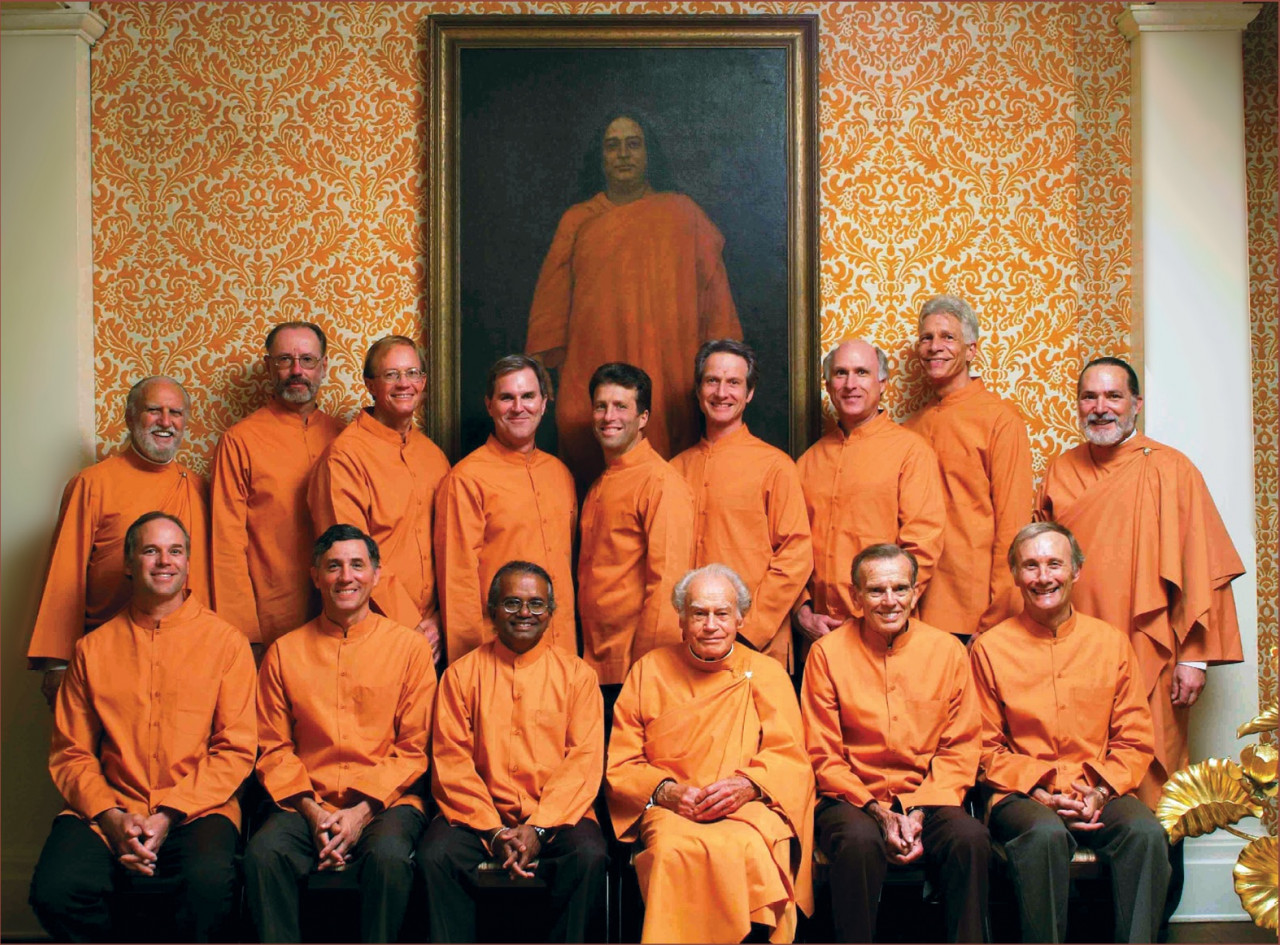
The ancient Swami Order to which Paramahansa Yogananda belonged thrives today in Self-Realization Fellowship monastic communities, consisting of monks and nuns from countries all around the world. As depicted in AWAKE, the documentary film on Yoganandaji’s life (released in 2014), this monastic order sustains the global growth of SRF and helps the wider dissemination of yoga among all nations.
In describing the monastic order he founded, Paramahansaji wrote: “For myself, such complete renunciation as a monk of the Swami Order was the only possible answer to the ardent desire in my heart to give my life wholly to God, uncompromised by any worldly tie….
“As a monk, my life has been offered in unreserved service to God and to the spiritual awakening of hearts with His message. For those on the path I have followed who also feel called to complete renunciation in a life of seeking and serving God through the yoga ideals of meditative and dutiful activities, I have perpetuated in the monastic order of Self-Realization Fellowship/Yogoda Satsanga Society of India the line of sannyas in the Shankara Order, which I entered when I received the holy vows of a swami from my Guru. The organizational work that God and my Guru and Paramgurus have started through me is carried on…by those who have dedicated their lives to the highest objectives of renunciation and love for God.”
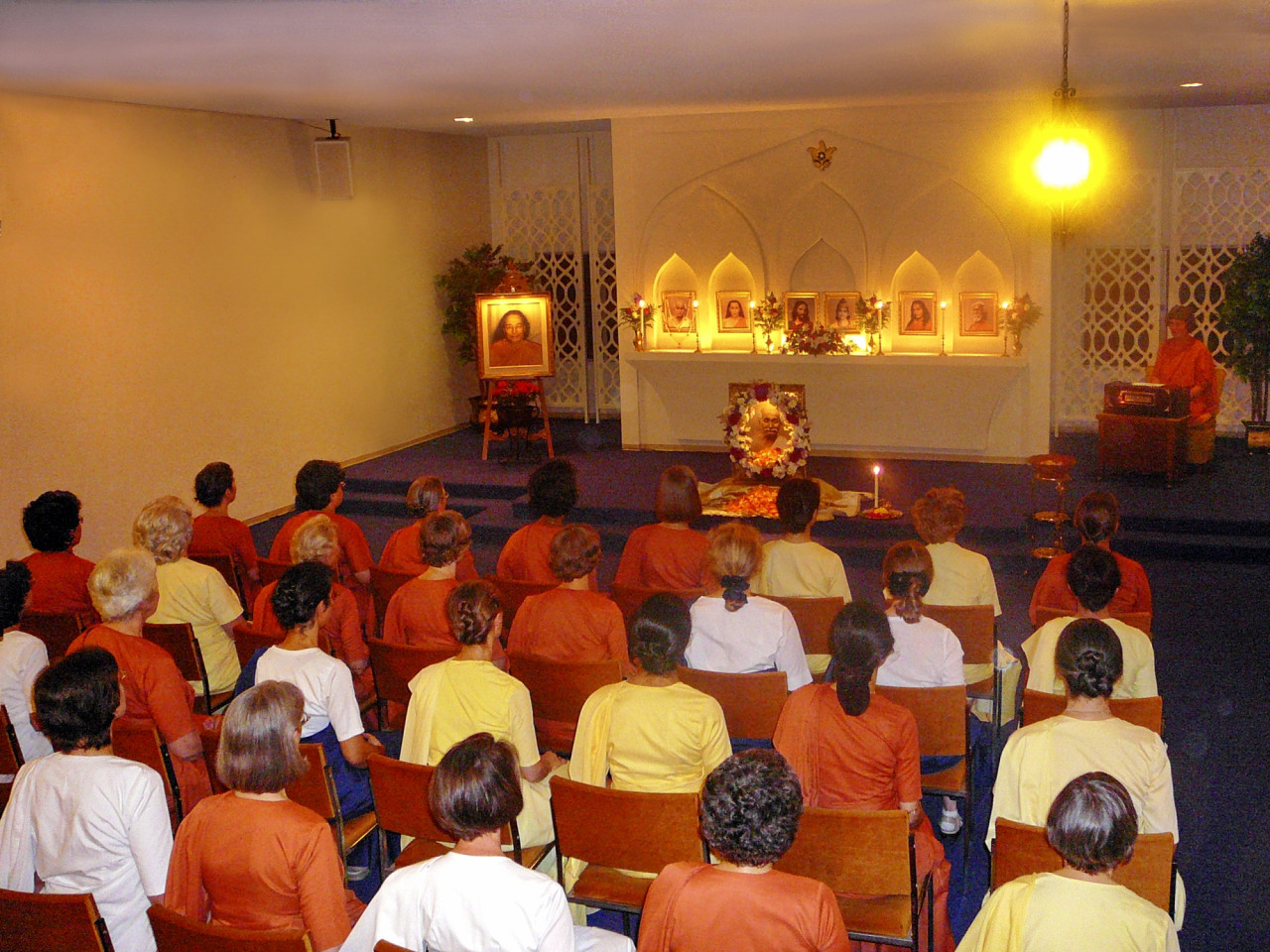
“I Become a Monk of the Swami Order”
By Paramahansa Yogananda
(Extracts from Autobiography of a Yogi)
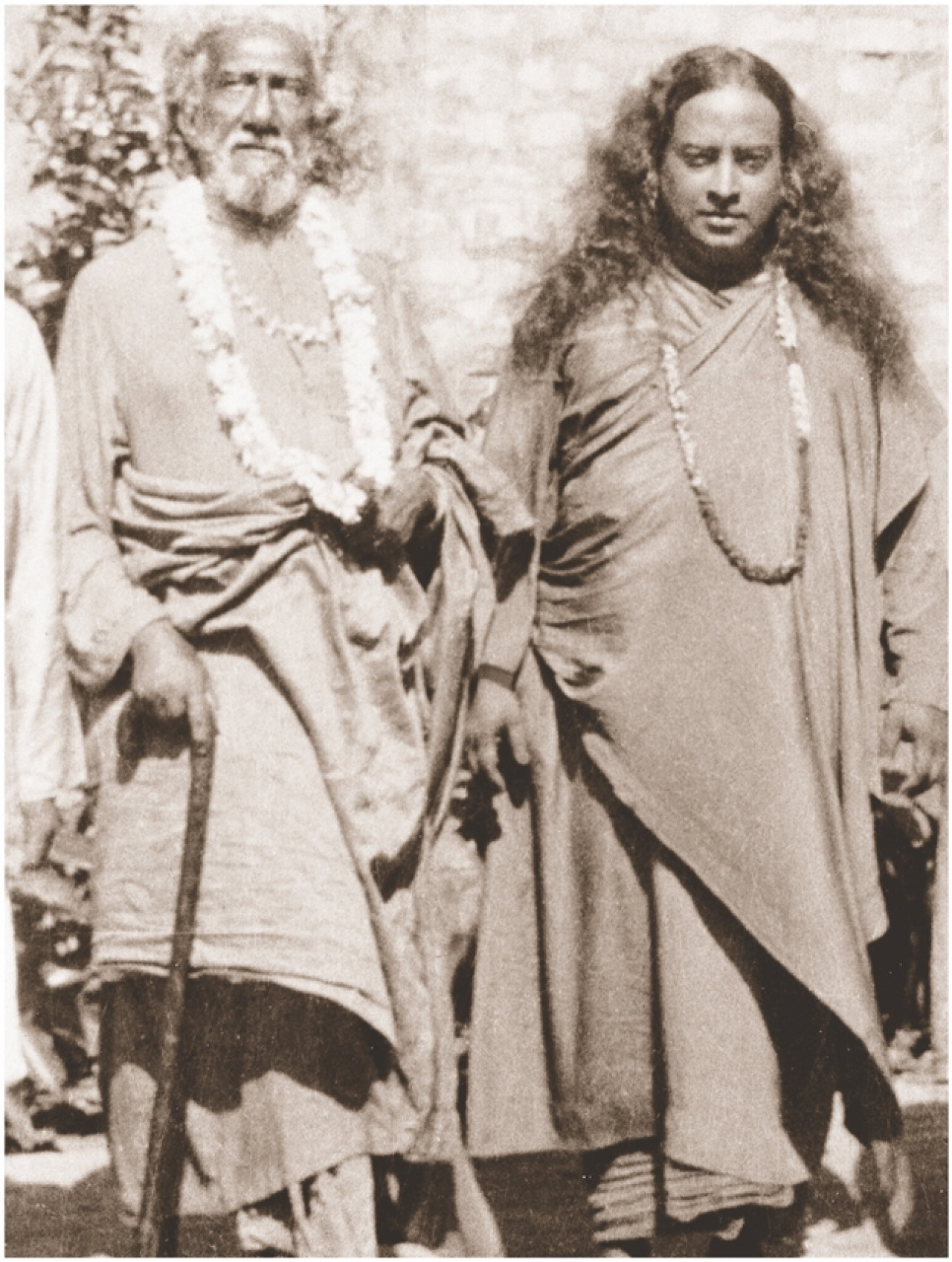
“Master, my father has been anxious for me to accept an executive position with the Bengal-Nagpur Railway. But I have definitely refused it.” I added hopefully, “Sir, will you not make me a monk of the Swami Order?” I looked pleadingly at my guru [Swami Sri Yukteswar]. During preceding years, in order to test the depth of my determination, he had refused this same request. Today, however, he smiled graciously.
“Very well, tomorrow I will initiate you into swamihood.” He went on quietly, “I am happy that you have persisted in your desire to be a monk. Lahiri Mahasaya often said: ‘If you don’t invite God to be your summer Guest, He won’t come in the winter of your life.’”
“Dear Master, I could never relinquish my wish to belong to the Swami Order like your revered self.” I smiled at him with measureless affection….
To allot the Lord a secondary place in life was, to me, inconceivable. He is the sole Owner of the cosmos, silently showering man with gifts from life to life. There is but one gift man may offer in return—his love, which he is empowered to withhold or bestow....
The following day was one of the most memorable in my life. It was a sunny Thursday, I remember, in July 1915, a few weeks after my graduation from college. On the inner balcony of his Serampore hermitage, Master dipped a new piece of white silk into a dye of ocher, the traditional color of the Swami Order. After the cloth had dried, my guru draped it around me as a renunciant’s robe….
As I knelt before Sri Yukteswar, and for the first time heard him pronounce my new name*, my heart overflowed with gratitude. How lovingly and tirelessly had he labored, that the boy Mukunda be someday transformed into the monk Yogananda! I joyfully sang a few verses from the long Sanskrit chant of Lord Shankara:
Mind, nor intellect, nor ego, feeling; Sky nor earth nor metals am I. I am He, I am He, Blessed Spirit, I am He! No birth, no death, no caste have I; Father, mother, have I none. I am He, I am He, Blessed Spirit, I am He! Beyond the flights of fancy, formless am I, Permeating the limbs of all life; Bondage I do not fear; I am free, ever free, I am He, I am He, Blessed Spirit, I am He!
How the Swami Order Came to the West
Before Paramahansa Yogananda’s passage to America in 1920, other pioneer swamis from India, such as Swami Ram Tirtha and Swami Vivekananda, had briefly visited America and spoken about Yoga and Vedanta in the West. Swami Vivekananda and his brother disciples of the Ramakrishna-Vedanta Society had even initiated a few Westerners into the sannyas life in the late 19th century on an individual basis. But it was Paramahansaji in the 20th century who organized a system of monastic training, succession, and inter-generational propagation in monasteries of the Swami Order such as had not been seen before.

Indeed, Paramahansaji’s specific mission of spreading the ancient meditation science of Kriya Yoga in the West and worldwide was integrally related with his historic expansion of the Swami Order in America. The monastic roots of Yogananda’s Kriya Yoga mission go back to the meeting of his guru, Sri Yukteswar, with Mahavatar Babaji, founder of the Kriya Yoga lineage in modern times. Babaji had first ordained Lahiri Mahasaya, a householder and family man, to begin the process of publicly teaching the Kriya science, which had been lost for centuries. Sri Yukteswar, like his guru, Lahiri Mahasaya, was also a householder (though widowed) — up until he met Mahavatar Babaji at a Kumbha Mela in Allahabad in 1894. Sri Yukteswar related that meeting as follows: “Welcome, Swamiji,” Babaji said affectionately.
“Sir,” I replied emphatically, “I am not a swami.”
“Those on whom I am divinely directed to bestow the title of swami never cast it off.” The saint addressed me simply, but deep conviction of truth rang in his words; I was instantly engulfed in a wave of spiritual blessing.
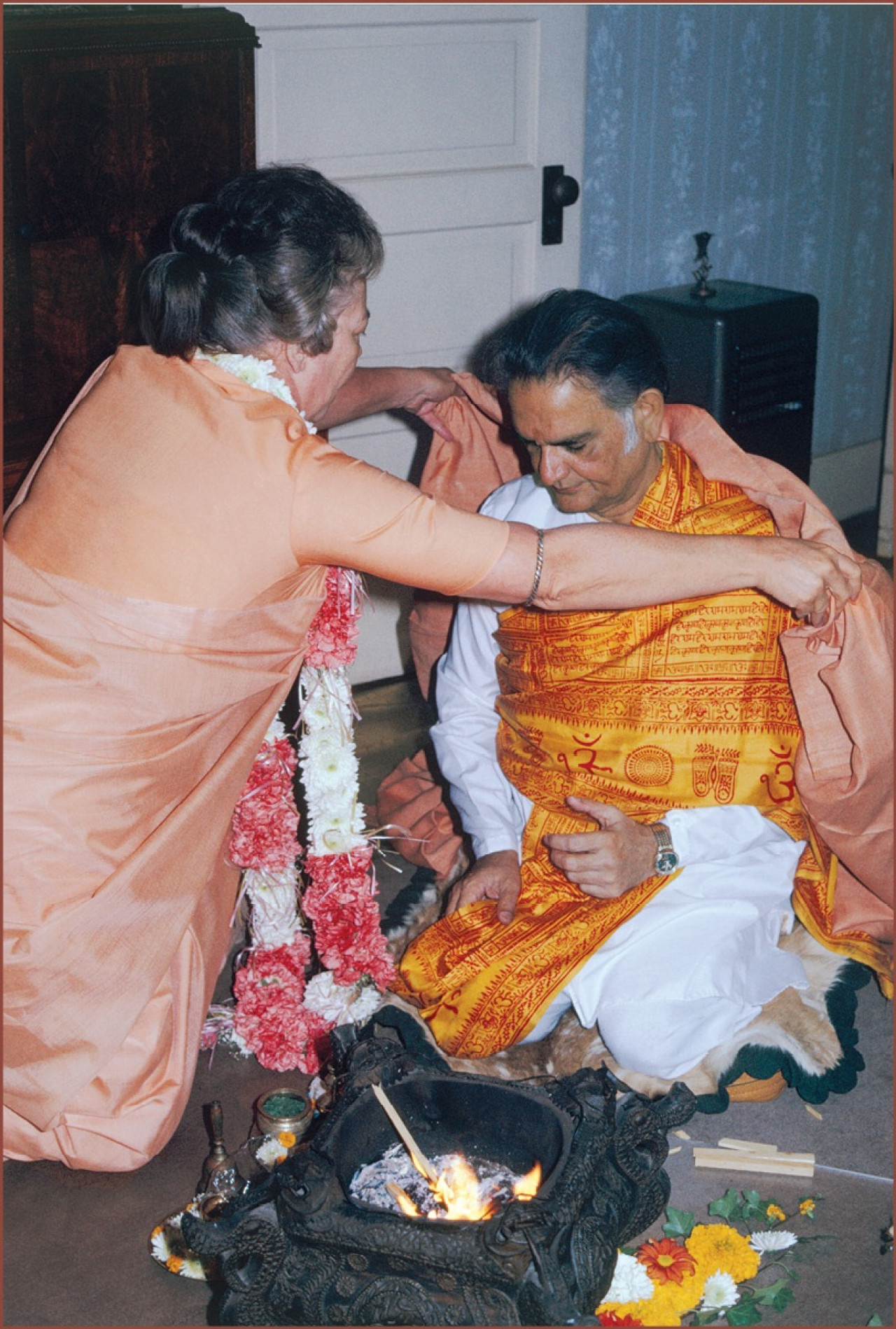
Babaji told the new swami: “Some years hence I shall send you a disciple whom you can train for yoga dissemination in the West.” That disciple, of course, was Paramahansa Yogananda, as was later confirmed personally by the Mahavatar to Paramahansaji. By making Sri Yukteswar a swami before sending Yogananda to him for training, Babaji thus ensured that the principal transmission of Kriya Yoga in the West and worldwide would be accomplished by consecrated renunciants of India’s ancient monastic tradition.
After the establishment of Self-Realization Fellowship international headquarters in Los Angeles in 1925, Paramahansaji gradually began to accept for training men and women who came with the desire to devote their lives wholly to the search for God. With the arrival of Sri Daya Mata, Sri Gyanamata, and other deeply dedicated early disciples, the hilltop ashram at Mt. Washington became home to a steadily growing family of renunciants, in whom he instilled the spirit and ideals of the monastic life, which he himself had embraced and so perfectly exemplified. The Guru also gave to his closest disciples — those to whom he entrusted the responsibility for the future of his mission — specific guidelines for the dissemination of his teachings and the continuance of the worldwide spiritual and humanitarian work he had begun. Today, that same in-depth spiritual counsel and discipline that he gave to ashram residents during his lifetime are being passed on to new generations of monks and nuns.
Thus, through Paramahansa Yogananda, the ancient monastic Swami Order from India put down deep and lasting roots in America. In addition to initiating qualified Westerners, Paramahansaji modified the orthodox tradition in another way: by giving the same sacred vows of sannyas and positions of spiritual leadership to women as well as to men, an unusual practice for his time. In fact, the first SRF monastic disciple to whom he gave swami vows was a woman — Sri Daya Mata, who later served as the spiritual head of SRF/YSS for more than half a century.
It was during Sri Daya Mata’s presidency that the senior head of the Swami Order in India — His Holiness the Shankaracharya of Puri, Swami Bharati Krishna Tirtha — was the guest of Self-Realization Fellowship during his groundbreaking three-month visit to America in 1958. This was the first time in the history of India that a Shankaracharya (apostolic successor of Adi Shankara, eighth-century reorganizer of the Swami Order) had traveled to the West. The saintly Shankaracharya had a profound regard for Sri Daya Mata, and gave his formal blessing on her further expansion of the Swami Order in SRF ashrams that Paramahansa Yogananda had begun at Babaji’s behest. After returning to India, he stated publicly: “I found in Self-Realization Fellowship the highest spirituality, service, and love. Not only do their representatives preach these principles, but they live according to them.”
Furthering the Work of Paramahansa Yogananda
Monastics of Self-Realization Fellowship further Paramahansaji’s work by serving in various capacities — including conducting annual public lecture tours and classes around the world, giving talks at Convocation, hosting the public at outreach events, doing office work, administering the society’s temples and centers and groups worldwide, overseeing the publication and distribution of SRF books and recordings, and counseling seekers on spiritual matters.
Brother Jayananda informally hosts members during regional retreat.
Sisters Chinmayi and Amaravati discuss an office project with a younger nun.
Brother Ishtananda offers spiritual guidance to devotees.
“God First, God Always, God Alone”
By Sri Mrinalini Mata
Extracts from remarks by the president of Self-Realization Fellowship to SRF monks and nuns
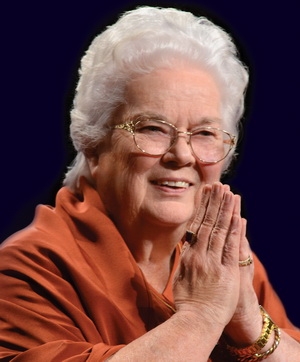
Dear ones,
The past few years have seen such rapid growth of our blessed Guru’s Self-Realization Fellowship; the work is expanding into a new era. So often we have remembered the words Master spoke many years ago to those of us who had come to dedicate our lives as monastics: “When I have left this body, the organization will be my body, and you all will be my hands and feet, my speech.” What a blessed opportunity, what a tremendously freeing experience is this life of consecration. Each one who wholeheartedly embraces it becomes like a glowing atom of Master’s being; each makes a necessary contribution to the whole, through which Gurudeva’s organization can continue to reach out in his spirit of love divine.
The world has so much lost sight of spiritual standards and morals. Those who choose the monastic path do so in response to the soul’s desire and ability to live a life above those ordinary materialistic norms. Though relatively few may embrace monasticism, those who live that life of disciplined striving help to keep the higher values before the gaze of the many. People do feel something different, special, from the purity of a life given to God alone. Abiding by the vows of simplicity, obedience, chastity, and loyalty, persevering in meditation and humbly trying to improve, make tremendous changes in the devotee. Even the little fleshly frame he lives in becomes recognizably spiritualized. Others cannot say what it is, but they feel from that devotee an aura that somehow uplifts them and speaks to them of God. The humble devotee makes no show of it; indeed, he may not even be aware of it.
There is no greater vocation — no greater success that one can attain, no greater fame in the eyes of eternity — than to dedicate oneself to the spiritual path. That one who succeeds, that one who serves from the soul, in attunement with God and Guru, silently and unbeknownst to himself changes thousands in the world. One day in the presence of God he can look back and say, “Oh, what Divine Mother and Gurudeva did with that little insignificant life!” The growth of Master’s work these many years is because of those in his spiritual family — the monastic community as well as the many devoted householder disciples — who have dedicated their lives toward becoming living examples of Guruji’s teachings and his spirit.
Master is the life and heart of Self-Realization Fellowship. His spirit is inculcated by our daily life in his ashrams. Master’s monks and nuns learn — in their behavior, in their demeanor, in their thinking, in their entire consciousness, no matter where their duties may take them — always to remember: “I have given myself to an ideal, the same spiritual criterion that lived in my Guru: God first, God always, God alone.” One whose life is truly consecrated to that ideal is someone to whom Guruji reaches out constantly in blessing, someone who becomes a fit instrument he can use to serve others, someone through whose life he can express God-love, God-understanding and caring, the forgiveness of Jesus, the wisdom of Krishna — all of the other godly qualities he manifested so beautifully, so joyously, in his own life. How blessed we are to have the opportunity in these ashrams he founded, not only to work for our own liberation, but in so doing to perpetuate the divine dispensation Gurudeva brought for the liberation of others and the upliftment of humanity.
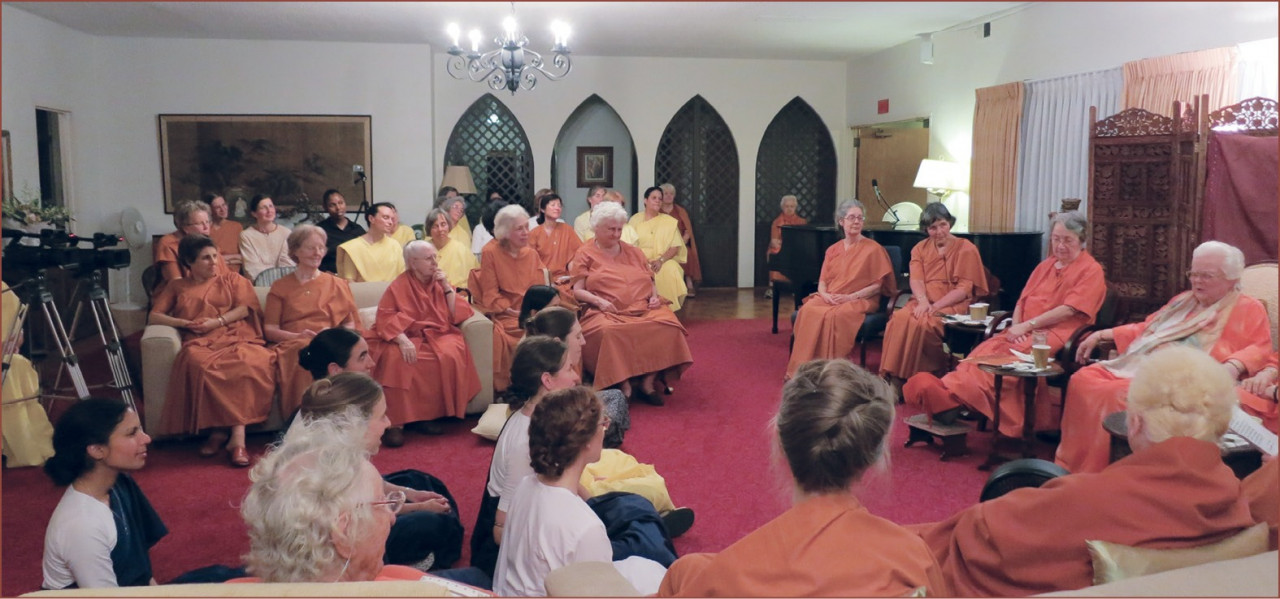
Invitation
Single men and women who are free of family obligations, and who have a sincere desire to dedicate themselves to finding God and serving Him as a monk or nun in the monastic communities of Self-Realization Fellowship, are invited to contact SRF Headquarters for information.


